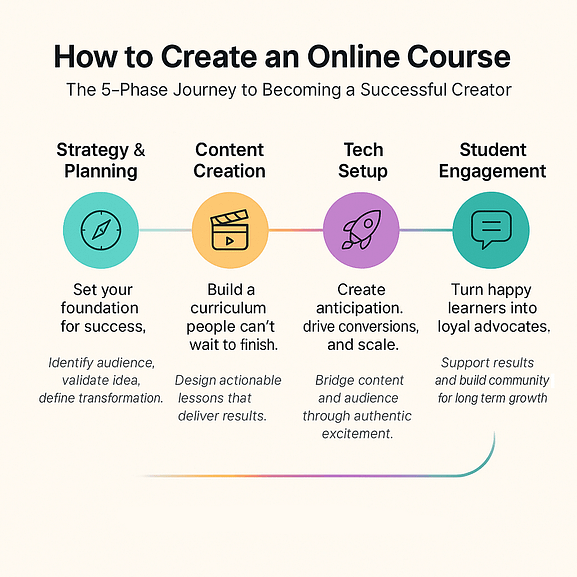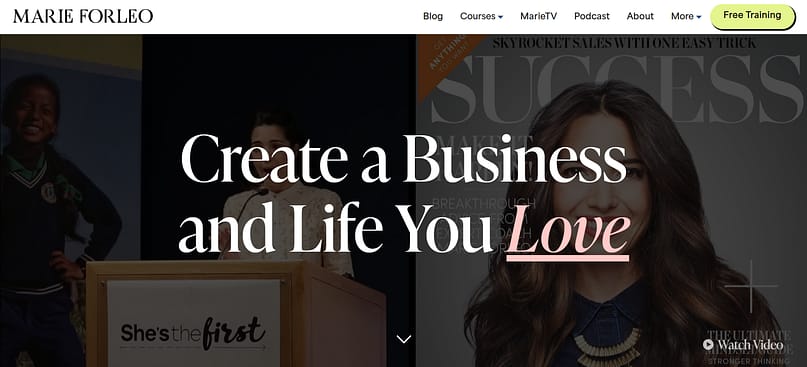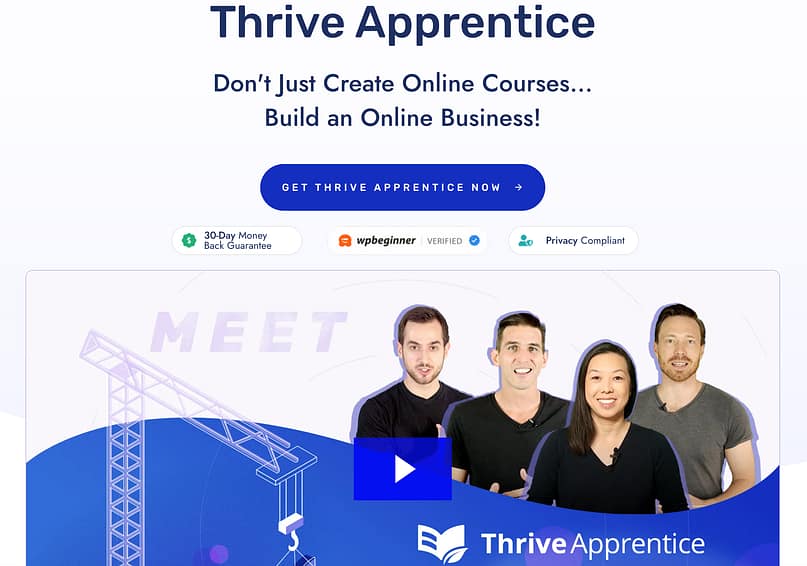TL;DR — How to Create and Sell a Profitable Online Course
This guide walks you through the entire journey of turning your expertise into a profitable, scalable online course business. It’s not about quick wins or recycled advice — it’s about building a system that creates transformation for your students and freedom for you.
You’ll learn how to move from idea to launch using a proven 5-phase framework, backed by practical strategies, real-world tools, and conversion-driven design. Every step ties back to one goal: helping you create an online course that grows your authority, income, and impact.
3 Key Takeaways
- Plan before you produce. Every profitable course starts with clarity — a validated idea, a defined learner, and a measurable transformation.
- Design for results, not lectures. Students remember progress, not slides. When you use structured learning design and active engagement, your course becomes its own best marketing.
- Build on a platform you own. With Thrive Suite, you control your brand, your data, and your revenue. The right tools turn your knowledge into a long-term, scalable business.
If you’re skimming, pause here — but come back for the full walkthrough. Each phase builds on the last, and by the end, you’ll have a step-by-step plan to create, sell, and grow your course the Thrive way.
What if the most valuable product you could ever create is already sitting in your head? Right now.
That thought drives nearly every creator I have worked with. Knowledge is the one asset that multiplies when shared. When you package it into a course, you do more than teach — you build a business that expands your reach, reputation, and revenue all at once.
I have spent years helping creators, coaches, and entrepreneurs turn expertise into sustainable income. The ones who succeed think differently. They do not chase trends. They focus on transformation. They understand that a great course is not a collection of videos — it is a bridge between what a student wants and the life or skill they are trying to build.
An online course allows you to:
I have seen these results firsthand. At Thrive, we have supported thousands of creators who built thriving course businesses on WordPress using our tools. They own their audiences, control their pricing, and design experiences that reflect who they are — no compromises, no middlemen.
This guide is your complete roadmap for doing the same. I call it the 5-Phase Journey of a Course Creator:
- Strategy & Planning — build a strong foundation that guarantees focus and clarity.
- Content Creation — design lessons that spark genuine transformation.
- Tech Setup — choose and connect tools that help you sell seamlessly.
- Marketing & Launch — create momentum that leads to conversion.
- Student Engagement — nurture loyalty and advocacy after the sale.
Each phase works like a gear in a larger system. Together, they create a business that grows with every new learner who joins your world.
Let us begin where every lasting success starts — with clarity, purpose, and a plan.
But First: Here Are the Most Asked Questions About “How to Create an Online Course”
Before diving into the full step-by-step process, let’s cover the questions most new creators ask when learning how to create an online course. These are the practical, “I just need to know where to start” moments — the same ones I’ve answered for hundreds of aspiring instructors and business owners. If you’re still exploring your idea or wondering what it really takes to build a course that sells, this section will give you a clear, grounded foundation.
Before you spend weeks building, test the demand. Use keyword research to see what people are searching for, explore online communities to identify pain points, and ask your existing audience what they’d love to learn from you. If you’re ready to validate more directly, offer a pre-sale or mini-workshop. When people commit money or time, you have proof that your idea has traction — not just interest.
You don’t need a PhD or a huge following to teach effectively. You just need to know your topic well enough to guide someone a few steps ahead of where they are now. In my experience, learners value clarity, structure, and empathy far more than credentials. Focus on helping them achieve real results, and your credibility will grow naturally.
The best online courses use a mix of formats. Short, engaging videos build connection; worksheets and text summaries reinforce learning; and audio lessons help busy learners stay engaged on the go. The key is to design every format around your learner’s experience. Ask yourself: what helps them apply the lesson — not just consume it?
You can host your course in three main ways:
- Marketplaces like Udemy or Skillshare offer quick exposure but limit your pricing and brand control.
- All-in-one LMS platforms such as Kajabi or Thinkific simplify setup but keep your business tied to monthly fees.
- Self-hosted WordPress sites offer complete control, long-term ownership, and flexibility.
I always recommend building on WordPress with Thrive Suite. It gives you full ownership of your audience, your data, and your profits — a true long-term business foundation.
Your course price should reflect the transformation you deliver. Research competitor pricing to find a market baseline, then position yourself based on the value your students gain — not the number of videos or hours of content. For higher perceived value, offer pricing tiers, bonuses, or limited-time enrollment windows. When done thoughtfully, pricing communicates confidence and attracts serious students.
Most creators can go from idea to launch in 8–12 weeks with a focused plan. The secret is to build iteratively — validate first, then produce. As for lessons, shorter works better. Aim for 5–10-minute videos or quick modules that create “small wins.” Learners stay engaged when they feel progress, not pressure.
Design for action, not just attention. Break lessons into clear milestones, include short quizzes or reflection prompts, and use community spaces for accountability. Celebrate wins publicly — even small ones. When students feel supported, completion rates soar, and success stories naturally feed your marketing.
A single course can evolve into a full digital ecosystem. Add advanced programs, membership tiers, or complementary mini-courses to keep students engaged. Then build around your brand: publish blog posts, host a podcast, or share snippets on YouTube. Consistent, valuable content keeps your funnel alive and your audience growing long after the first launch.
👉 If you’re new to teaching, start with our How to Teach Online guide — it breaks down the fundamentals of teaching effectively, even if you’ve never stood in front of a classroom.
How To Create an Online Course: Use the 5-Phase Journey to be a Successful Creator
Every thriving course I have helped build follows the same rhythm — five deliberate phases that turn raw ideas into profitable, long-term businesses.
Most creators fail because they skip steps. They rush to film, upload, and launch before laying the groundwork that actually makes a course sell. These five phases keep you from falling into that trap. They give structure to creativity and turn scattered effort into predictable progress.
Before we dive into each phase in detail, here is the full journey you are about to take.
Phase 1: Strategy & Planning — Set your foundation for success.
I always say this, “Every strong course begins long before the camera turns on.”
You identify the right audience, validate the idea, and define the transformation your course will deliver. This phase anchors everything that follows.
Phase 2: Content Creation — Build a curriculum people cannot wait to finish.
Once your strategy is clear, you design lessons that teach through action. Real learning happens when students see progress, not when they watch endless slides. This phase focuses on shaping content that drives results and builds authority at the same time.

Phase 3: Tech Setup — Choose the right platform and automate your system.
Remember: Technology should serve you, not the other way around.
You decide where your course lives, how students access it, and how automation supports both learning and sales. And you’ve got to be intentional about your tech stack for your online course system – it can really make or break your success.
Here, I’ll suggest using a tool like Thrive Apprentice, where you get to maintain complete control of your platform and brand.
Phase 4: Marketing & Launch — Create anticipation, drive conversions, and scale.
Now, online course creation is just the start.
Your product won’t succeed on its own. You need to build excitement before launch day, design a funnel that nurtures trust, and create urgency that feels authentic. Marketing is the bridge between your content and the people who need it most.
Phase 5: Student Engagement — Turn happy learners into loyal advocates.
A successful launch is only the beginning. Long-term success depends on how well you support students after they enroll. This phase helps you strengthen community, encourage results, and turn genuine student success into social proof that sells future enrollments.
Each phase connects to the next, forming a full business ecosystem — from the first spark of an idea to a thriving course that runs smoothly and continues to grow.
Now that you understand the path, let us begin at the start: planning your course and becoming an effective online teacher.
Phase 1: Plan Your Course and Master the Art of Teaching Online
Before I ever sketch a lesson outline or record a video, I begin with clarity.
A strong course always starts long before the first slide deck or camera setup. You need a reason for creating it that goes beyond income — a purpose that ties your expertise to the transformation your students want most.
Define the Idea That Sits at the Intersection of Passion, Skill, and Demand
I often use a framework called Ikigai when helping creators shape their ideas. It asks four simple but revealing questions:
The overlap between those answers is your starting point. When you operate from that center, you stop guessing about what to teach and start building something that holds long-term commercial value.
Validate Market Demand Before Building Anything: Do People Actually Want Your Course?
Great ideas fail when they are built in isolation. The last thing you want is to spend weeks (or even months) building a course… only to realize no one wants or need it.
And that’s where validation comes in. It makes sure you’re on the right path and targeting the right people. I look for three clear signals before I create content:
- Search demand: Use keyword tools to check if people are already seeking information around your topic.
- Community chatter: Browse Reddit threads, Facebook groups, and niche forums to listen for repeated questions or frustrations.
- Direct feedback: Send short surveys or host polls through your email list or social channels. A few genuine responses often reveal more than hours of data scraping.
If you confirm that people want what you plan to teach, you have already reduced most of the risk that stalls new creators.
Define Your Target Learner Persona: Who Are You Creating For?
Every effective course speaks to one person, not everyone. I like to imagine a specific learner — name, background, motivation, and current challenge.
Ask yourself:
- What problem are they trying to solve?
- How do they prefer to learn?
- What obstacles keep them from making progress?
When you understand this learner deeply, every marketing message, lesson title, and worksheet becomes sharper and more persuasive.
Phase 2: Design a Curriculum That Creates Real Transformation
When I help creators design their courses, I always remind them that students do not remember slides — they remember progress. A strong curriculum does more than deliver information. It builds momentum. Each lesson moves the learner closer to a visible, measurable result. That result becomes your strongest marketing tool.
Structure Your Course Like a Learning Experience, Not a Lecture
The structure of your course determines how well students stay engaged. I approach it the way an architect approaches a blueprint — clear pathways, visible milestones, and no wasted steps.
Think of your content as a sequence of modules and micro-lessons.
Short, well-paced lessons help learners feel capable. Confidence leads to completion, and completion leads to advocacy.
Use Backward Design to Keep Every Lesson Purposeful
Backward Design begins with the end in mind. I start by asking one question: What should a student be able to do when they finish this course?
That answer becomes the destination. From there, the path becomes clear:
This process prevents unnecessary content and keeps the learning experience focused on transformation rather than volume.
Add Engagement Boosters That Deepen Learning
Attention fades quickly online, so every course needs moments that bring learners back into focus. I like to mix in:
Engagement design is not decoration. It is part of learning psychology. Small, visible wins make students feel capable, and capable students talk about your course.
👉 To go deeper into building participation and retention, check out How to Keep Students Engaged in Online Courses. It’s full of tactics to sustain attention and motivation beyond the first few modules.
Phase 3: Set Up the Tech That Powers Your Course Business
Technology can make or break a course business. I have seen creators lose months chasing “easy” tools that quietly limit what they can grow into. The goal is not to find whatever works today. The goal is to build a platform that belongs to you, scales with you, and converts reliably.
Build Your Course Platform Once — and Own It Forever
There are three main paths every course creator faces. Each one offers different trade-offs between control, convenience, and audience ownership.
- Hosted Marketplaces – These are platforms like Udemy or Skillshare. They attract large audiences but keep tight control over pricing, branding, and data. Your name sits under their logo, and your students belong to their system.
- All-in-One LMS Platforms – Think of services such as Kajabi or Thinkific. They give you more creative control and include built-in payment and marketing tools. They are user-friendly, but monthly costs rise quickly, and you still build on someone else’s property.
- Self-Hosted WordPress Setup – This is where long-term freedom lives. You own the domain, the data, the brand, and the experience. You decide how everything looks, functions, and scales.
I always recommend this third option for creators who want a real business, not just a course listing.
Find the Sweet Spot: WordPress + Thrive Apprentice
I’ve seen the shift happen countless times — the exact moment a creator moves from “building a course” to owning a brand.
That’s what Thrive Apprentice unlocks.
WordPress provides the freedom to design your business on your own terms. Thrive Apprentice brings that vision to life with structure, flow, and design that make your learning environment feel professional, intuitive, and genuinely yours.
Why Thrive Apprentice Stands Out
Feature | Benefit for Course Creator |
|---|---|
Everything in one place | Lessons, access control, progress tracking — all in one clean dashboard. |
Built for creativity | The interface feels modern and fluid, made for creators who value design as much as teaching. |
Total control | From pricing and branding to community and student experience, every decision stays in your hands. |
Whenever I help someone move from a hosted platform to Thrive Apprentice, I notice the same reaction — a deep sense of freedom. Their site finally looks and feels like them. Their message carries through every page. And once that alignment clicks, growth follows naturally.
👉 Before you decide, you might enjoy this hands-on Thrive Apprentice Review — it walks through setup, selling, and the real student experience.
Build a Timeless Course Business with Thrive Suite
Thrive Suite brings every piece together — so your online course grows into a brand your students remember for years.
Together, they transform your course into an ecosystem — one that guides, teaches, and converts while strengthening your identity as a creator.
When design, marketing, and education work in harmony, your course becomes more than a product.
It becomes an experience — one that stands out, scales beautifully, and stays memorable long after the first enrollment.
Phase 4: Launch and Market Your Course Like a Pro
A launch should feel like an event, not an announcement. The difference lies in how well you prepare your audience before enrollment ever opens. I always tell creators that a strong launch starts weeks earlier — in quiet moments of trust-building long before the first sales email.
Turn Your Audience into Eager Students Before You Open Enrollment
Momentum begins with anticipation. I start every pre-launch with three simple pieces:
When you approach marketing as education, your audience moves naturally from learning to buying. They already trust your voice by the time the offer arrives.
👉 For a step-by-step walkthrough on building your audience before launch, read our Email Nurture Sequence Guide.
Build a Sales Page That Converts Through Clarity and Emotion
Your sales page does not need to shout to be persuasive. It needs to reflect what your audience truly wants to achieve.
I design each page in Thrive Architect, because visual storytelling matters. The layout guides the reader from desire to decision:
Every block on the page should earn its place by answering one question: Why now?
👉 If you’re writing your own sales page, this guide on How to Create the Perfect Long-Form Sales Page shows real examples and templates that boost conversions.
Use Scarcity and Urgency with Integrity
Scarcity works when it feels honest. Early-bird pricing, limited enrollment periods, or exclusive bonuses encourage commitment, not pressure. I prefer to set real enrollment windows, then close the doors as promised. Consistency builds credibility, and credibility converts.
💡 And to master ethical urgency, explore our article on Time-Based Marketing — it shows how to create real FOMO without fake pressure.
👉 If launching feels overwhelming, our 6-Figure Product Launch Funnel Guide breaks the process into actionable steps you can mirror for your course.
And once your course is live, check out How to Increase Course Sales for proven strategies to keep your enrollments growing month after month.
Phase 5: Keep Students Engaged and Turn Them Into Advocates
The real work begins after enrollment.
A sale creates revenue, but a result builds reputation — and reputation fuels every future launch.
Here’s how I keep students engaged, supported, and excited long after they buy.
👉 If you plan to expand your course into a full membership experience, this Membership Engagement Strategy guide will show you how to build community and long-term connection.
Case Study Spotlight: Marie Forleo’s “B-School” and the Power of Lifetime Access
Every great course creator leaves a clue. One standout example is Marie Forleo, the creator of B-School — a global business education program that has helped thousands of entrepreneurs build sustainable, purpose-driven brands.
Marie approaches her course like a living ecosystem, treating it as an ongoing experience rather than a one-time purchase.

What Makes Her Approach Unique
Her students enroll once and continue to grow within the program year after year. Alumni receive access to the latest version of the course, community calls, and bonus content every time a new cohort begins. That single design choice reshaped her business model in three key ways:
How to Apply This to Your Own Course
You can adapt this strategy on any scale. The goal is to design for longevity, community, and re-engagement from the very beginning.
This approach redefines what it means to launch. Each new round builds on the last, compounding credibility, engagement, and revenue. That’s how course creators turn a single program into a long-term brand asset.
Explore Advanced Strategies and Tools (The Thrive Way)
Once your course is live and running, the real fun begins — experimentation. I love this stage because it rewards curiosity. You already have a working system; now you can start layering in features that turn a good learning experience into a remarkable one.
Experiment with the Systems That Top Creators Use
Think of these as your innovation levers — simple enhancements that create delight and deepen engagement.
Your 90-Day Course Creation Roadmap
You do not need a year to launch. You need focus, structure, and the courage to start. I’ve seen creators move from idea to income in under three months — not because they rushed, but because they worked with direction.
Here’s the roadmap I share with them:
90-Day Course Creation Timeline
Timeline | Action Steps |
|---|---|
Weeks 1–2 | Validate Your Idea and Audience. Test your topic, define your learner persona, and confirm real demand. Don’t guess — gather data through keyword research, surveys, or direct feedback. |
Weeks 3–4 | Plan Your Modules and Outcomes. Outline your curriculum with clear, measurable results in mind. Use Backward Design so every lesson serves the end goal. |
Weeks 5–6 | Produce and Upload Lessons. Create in batches. Focus on clarity, not perfection. Record lessons, design worksheets, and prepare supplemental materials. |
Weeks 7–8 | Build Your Website and Funnel. Set up your course with Thrive Apprentice and design your sales page in Thrive Architect. Make sure every path leads to a conversion. |
Weeks 9–10 | Grow Your List and Pre-Sell. Launch your lead magnet, nurture your audience, and pre-sell your course at an early-bird price. Pre-sales validate your idea and fund your final polish. |
Weeks 11–12 | Launch, Review, and Improve. Open enrollment, celebrate your first students, and gather feedback. Use insights to refine your content and build momentum for the next cycle. |
Conclusion: Build Once, Sell for Years
Every phase you’ve just walked through leads back to one simple goal — freedom.
Not the vague kind that fills social media quotes, but the kind you can measure: control over your time, ownership of your audience, and income that grows even when you step away.
When I help creators design their first course, I remind them that they’re not just creating content — they’re building a business.
A business that scales without burnout, earns through genuine transformation, and keeps evolving alongside its students.
That’s the mindset shift every successful creator makes: from hustling to teaching, from selling hours to selling systems.
With Thrive Suite, you have the tools to make that shift real. From your first idea to your first sale — and every funnel, page, and student interaction in between — the entire ecosystem works together to help you build with confidence and sell with intention.
Your next step is simple:



